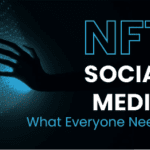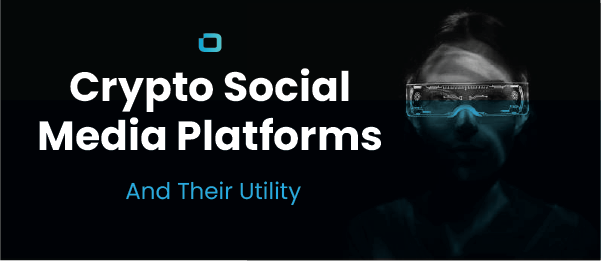

The Future With Decentralized Social Media Platforms
Decentralized social media platforms are a huge leap ahead of traditional platforms and aim to provide numerous benefits when it comes to the use-cases and functionality of these platforms. Let’s go over what they are and how they work.
Decentralized Social Media Platform
Social media has essentially reshaped the way we communicate and interact with one another easily.
From MySpace to Facebook and many other social media platforms that have been created ever since, social media platforms have become a necessity in our everyday lives, especially if we want to stay in the loop with our social circles and get the latest in terms of what is happening in the lives of the people we like.
However, so far, the most popular social media platforms have been heavily centralized; in other words, all of the content has been under the control of the companies that have built NFT social media platforms.
This means that they have the power to block content, ban accounts, and are in complete control of everything that happens.
Blockchain social media platforms are aiming to disrupt the space, and today, we are going to go over everything you need to know.


How Decentralized Social Networks Work
If you have ever wondered how to build a decentralized social network, you will need to know how they work first.
The main issues surrounding the social media industry are the fact that it has been littered with censorship, lack of customization features, monetization, which is not fair to everyone, and an algorithm that promotes dictatorship, alongside a monopoly across all of the network effects.
With that in mind, you might be wondering how decentralized social crypto works and how they can bring a change to this space.
The Social Graph is a key feature that many centralized and decentralized social media platforms utilize. This is essentially a model of a social network that is responsible for the process of mapping everyone on a platform and establishing how they are related. This, in turn, allows them to communicate with one another by leveraging the front end of the platform, the things they can see, click on, and interact with.
However, traditional social media platforms will typically be self-contained and will be hosted on the servers of the companies that made them.
Facebook, Twitter, TikTok, Instagram, all of these social media platforms own all of the content on them. Each user agrees to all of this in the terms and conditions and privacy policy pages, which they have to confirm and agree with at the point in time when they create an account.
On the other hand, decentralized social media crypto platforms live on top of a decentralized ledger, or more specifically, the public blockchain that they are built on top of. Anyone, anywhere, at any point in time, can operate a node and access the back-end of the network or even create an application and curate the feed.
You can think of them as a distributed social network variation that features a social token platform that powers it.
How Is Blockchain Used in Social Media?
Blockchain social media runs on top of a decentralized networking platform and is directly built on top of a blockchain protocol or platform, enabling applications to be developed through smart contracts.
Ethereum (ETH), Cardano (ADA), and Solana (SOL) are just some examples of blockchains that support the development of decentralized applications (dApps).
Due to the fact that they are essentially decentralized, these social media networks are not under any central authority that holds or can control all of the data within them. This is due to the fact that the data gets stored in a homogenous and decentralized way across the servers of each node that forms the network, all of which are spread out across the world on a global scale.
Due to all of this, social media platforms that are based on blockchain technology support social networking, content sharing, and blogging; however, they also enable end-to-end encryption for every interaction that occurs on top of them.
Most of them support specific features that are found within many ecosystems, including in-platform transactions, rewards for users through a specific, purpose-built utility token, and opportunities for decentralized crowdfunding.
Features of the Decentralized Social Media
There are specific features within decentralized social media networks that cannot be understated, and to truly understand them, we need to go over what each of them contributes.
Specifically, in social media networks, advertisers are the customers, and the users are the products. This means that they typically end up earning revenue through the procedure of selling the personal data of users to marketers that want to get to a specific target audience.
Alongside this, social media platforms that are centralized are located on a centralized server and, as such, have a high chance of getting compromised, where the emails, passwords, and identities of the users can be stolen.
Social media built on top of blockchain technology allows for a higher level of privacy and freedom of expression and a larger scope for crowdfunding.
By being connected to a peer-to-peer, end-to-end encrypted network, that does not have third parties that are centralized connected to it; users can essentially gain the most privacy of their data.
This is secured through the usage of private and public keys, where through the private key, each user can essentially create a transaction, where all of the details associated with it are stored in a data block that is a part of the overall chain.
This block gets added to the chain only after it has been verified by the consensus protocol, which is carried out by the miners and nodes’ network members. The data will only be accessible to the recipient. This is stored in the form of a cryptographic hash, which is a one-way algorithm that cannot be decrypted, in theory, to get the original data.
Each hash is unique, and every unique piece of information essentially has a different hash, all of which gets stored on top of a blockchain.
Unlike centralized social media, where the interaction can be monitored and accessible by those that run the network, in a decentralized network, user privacy is greatly increased, which leads to a higher level of freedom of speech as well as expression.
A majority of decentralized networks reward all of their users, especially the nodes that post on their network, which means that it rewards interaction and incentivizes users monetarily to be a part of the network. Due to this, crowdfunding efforts and campaigns are a lot easier to process and maintain, as anyone can be a part of them with ease.
Advantages of Decentralized Social Media Platforms
There are numerous advantages of decentralized social media platforms, including:
- Increased security
- Increased user control
- Higher monetization
- Less downtime
- No censorship or control from a middleman
What is the Most Decentralized Blockchain?
Based on all of the blockchain platforms created so far, many agree that Bitcoin is the most decentralized cryptocurrency and blockchain network out there.
As of September 1, 2022, there are a total of 46,228 nodes that run its software. This is higher when compared to Ethereum, for example, which has a total node count of 5,609.
Furthermore, Bitcoin is one of the first blockchain networks to truly grow in terms of popularity and appeal and is the number one blockchain in terms of market capitalization, all of which contribute to its decentralization.
Disadvantages of Decentralized Social Media
While there are a lot of advantages, there are also specific disadvantages of decentralized social media, and these include:
- Hate speech
- Propaganda
- Illegal content spreading speed
The Future of Decentralized Social Networks
Blockchain technology, as well as decentralized social media platforms, are currently just at their beginning.
It is likely that we will see a lot of developments as well as an evolution of the concept surrounding decentralized social networks at some point in the future.
To truly understand the future of decentralized social networks, we first need to look at their current state. Specifically, whenever you create an account on a social media platform, you have to create a separate account, preferably a separate password for every single platform, after which you upload content to every single platform individually.
This means that users are giving access to their data to multiple companies and have to individually disconnect them or disable them if that is at all possible.
In the future, users should theoretically be able to have one central cryptocurrency wallet that features their data, such as their email, name, age, image, and so on, where they can connect it to a social media platform using their private key, and disconnect at any point in time, taking all of the data with them.
This will prevent them from having to re-create an account each time, as all they would have to do is enter their private key and connect with their pre-configured data on each platform. All users will also be able to access decentralized media.
This way, users have full control over their data, free speech, censorship resistance, privacy as well as a high level of security, without companies being able to sell that data later on. If you want to gain insights regarding how these things work, Blockify can make it easier for you. It allows you to explore the world of Web3 and Defi with just a few taps, follow your favorite projects, and get social.
The social media network can essentially just leverage the network fees that occur throughout the usage of the network as a means of incentivizing the nodes to keep the social media network running.







